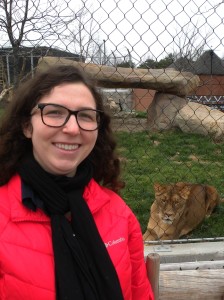Catherine Pelletier
MSc. Student
Contact Information
Department of Biology
Concordia University (Loyola Campus)
7141 Sherbrooke St. W. H4B 1R6
Montreal, QC, Canada
Office: SP301.16
Lab: SP434
(514) 848-2424 (ext. 4021)
catherine.s.pelletier@USherbrooke.ca
Education
2017-Present: MSc. Biology at Concordia University, Montreal, QC
2013-2016: BSc. Ecology + Certificate in Field Ecology, at Université de Sherbrooke, Sherbrooke, QC
My Project
Impact of anthropogenic noise on the welfare of zoo-housed animals
Background
There can be many stressful factors for animals in the zoo environment, such as disruptive noises. While most studies focused on the visitor effect, and generally found that the presence of visitors and their noise pollution negatively affected the captive animals’ behaviour, few have addressed anthropogenic noises in general. In addition, other frequencies outside the human-hearing range are frequently overlooked, such as infrasounds and ultrasounds. Numerous constant sources of low and high frequencies levels can be found in zoos, and various animals are sensitive to them, mostly mammals. Since high sound levels can be stressful for animals, more research is needed to describe the acoustic nature of zoo environments, particularly with the sounds outside the human hearing range. This study assessed the impact of noises on animal welfare, and evaluated the soundscape of the zoo in different contexts.
Field Work
This research took place during summer 2018 and winter 2019 at Zoo de Granby, Granby QC. The zoo currently houses many species that are sensitive to low and high frequencies, such as bats, felines, primates, carnivores and other mammals. Activity budget observations and spatial use were noted for the felines, as a proxi for welfare. Sound pressure levels were measured with an acoustic recorder. Also, 24h cycles of sound recording were performed at 25 locations of different contexts (indoor/outdoor/near noisy sources, summer/winter, visitor present/absent, daytime/nightime).
Objectives
One objective was to analyze the effects of sounds on the behaviour and spatial use of captive felines, and assess the implications for their welfare. Another was to evaluate the soundscape of the zoo, as to determine what characteristics of an environment are potentially problematic for animal welfare. .
This study has a broad objective of raising awareness of this issue to the zoo community in an attempt to promote captive animals’ welfare and therefore, improving the breeding success and conservation of endangered species. By developing our knowledge of the zoo’s complex acoustic environment and how these sounds might affect captive animals, zoo keepers will be able to develop effective strategies for mitigating such effects.
Publications
- Pelletier*, R.B. Weladji, P. Paré & L. Lazure (2018) Impact of anthropogenic sounds on the welfare of zoo animals. Quebec Centre for Biodiversity Science (QCBS) Annual Conference, December 10-12th, 2018, Montreal, QC, Canada (poster and oral presentation)
- Pelletier*, R.B. Weladji, P. Paré & L. Lazure (2018) Impact of anthropogenic sounds on the welfare of zoo animals. Association of Zoos and Aquariums (AZA) Annual Conference, September 23-27th, 2018, Seattle, WA, United States of America (poster presentation
- Pelletier*, R.B. Weladji, P. Paré & L. Lazure (2017) Impact of ultrasounds and visitor noise pollution on the behaviour and welfare of zoo animals. Société Québécoise pour l’Étude Biologique du Comportement (SQEBC) Annual Conference, November 3-5th, 2017, Ottawa, ON, Canada (poster presentation)